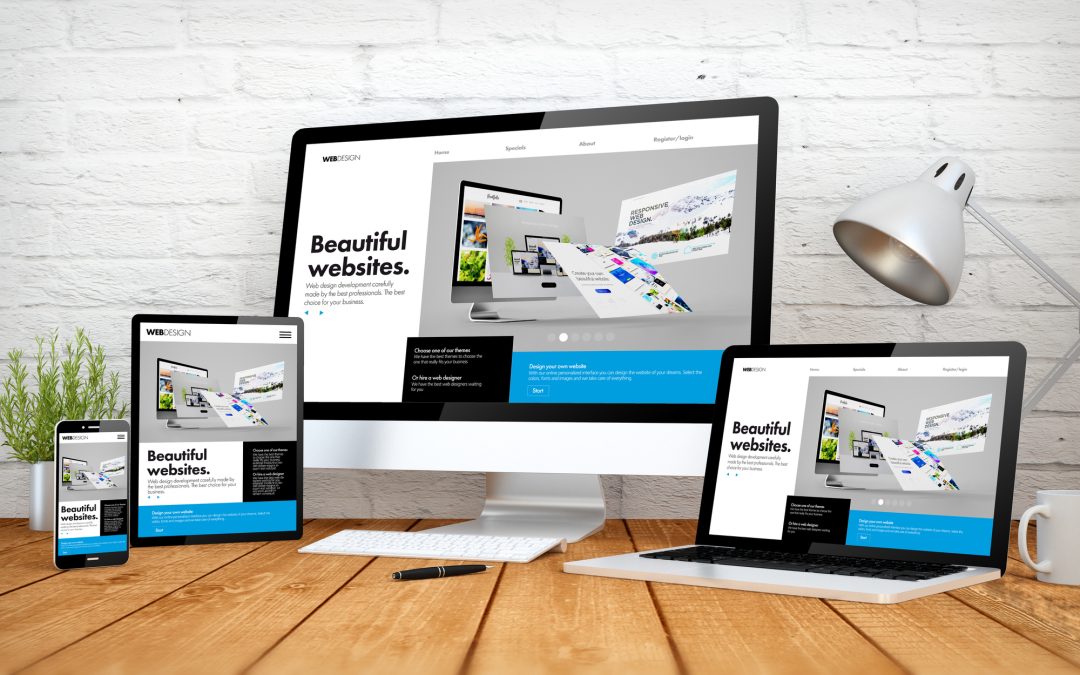Great website design is crucial for business growth today. Your website is your company’s online face; consequently, it’s key to attracting and keeping customers. With the right online presence, you can not only improve user experience but also boost your brand’s visibility. This turns clicks into loyal clients. This article explores the importance of a well-designed website and gives practical strategies to optimise your digital presence for long-term success.
Importance of Effective Website Design
Attracting and Retaining Customers
 A great website is vital for gaining and keeping customers. First impressions form fast, often in seconds. Therefore, good website design makes your business look credible and trustworthy, engaging visuals, easy navigation, and relevant content grab attention and encourage users to explore more. Additionally, a clear website improves the user experience. It makes it easy for clients to find information and take actions like asking questions or making purchases. By focusing on good website design, you create an environment that helps retain customers by offering value and building loyalty. In the online market, your website’s power to attract and keep users can greatly affect business growth.
A great website is vital for gaining and keeping customers. First impressions form fast, often in seconds. Therefore, good website design makes your business look credible and trustworthy, engaging visuals, easy navigation, and relevant content grab attention and encourage users to explore more. Additionally, a clear website improves the user experience. It makes it easy for clients to find information and take actions like asking questions or making purchases. By focusing on good website design, you create an environment that helps retain customers by offering value and building loyalty. In the online market, your website’s power to attract and keep users can greatly affect business growth.
Improving user experience is critical in website design. A smooth journey keeps visitors engaged and helps conversions. For instance, a clear layout, quick loading, and mobile-friendly design offer a smooth experience across devices. A good website predicts user needs by providing easy navigation and quick access to key info. This lowers frustration and encourages longer visits. Features like chatbots or personalised tips further enrich user experience, making interactions more engaging and tailored to personal likes. Focusing on user experience helps businesses create inviting spaces that lead to repeat visits and customer loyalty. Indeed, prioritising user experience in design leads to business growth, as happy users are more likely to become clients and advocates for your brand.
Driving Business Growth
Good website design can drive business growth through boosting brand visibility and conversion rates. Your website acts as a 24/7 digital store or salesman; thus, it reaches more people and opens new opportunities. Optimising for search engines and user experience increases organic traffic and engagement. Furthermore, using analytics tools gathers insights into user behavior, allowing data-driven choices that boost performance and profits. Consequently, your website becomes a hub for interaction, building trust and credibility, essential for growing over time. Therefore, investing in website design isn’t just about looks; it’s a plan to move your business ahead in a competitive market.
Key Elements of Professional Website Design
Visual Appeal and Branding
 Visual appeal and branding are key in professional website design. A visually appealing site attracts visitors and, importantly, leaves a lasting mark, crucial in tight markets. Consistent branding across your site strengthens your brand identity, making your business easy to recognise and remember. For instance, use a matching color scheme and typography that suits your brand’s style. Additionally, include high-quality images that connect with your target audience. Strategically use your logo and brand elements for a unified look. Using space effectively improves readability and highlights key content. As a result, a well-branded and appealing website captures attention, builds trust, and invites engagement. It plays a big role in nurturing brand loyalty and driving growth.
Visual appeal and branding are key in professional website design. A visually appealing site attracts visitors and, importantly, leaves a lasting mark, crucial in tight markets. Consistent branding across your site strengthens your brand identity, making your business easy to recognise and remember. For instance, use a matching color scheme and typography that suits your brand’s style. Additionally, include high-quality images that connect with your target audience. Strategically use your logo and brand elements for a unified look. Using space effectively improves readability and highlights key content. As a result, a well-branded and appealing website captures attention, builds trust, and invites engagement. It plays a big role in nurturing brand loyalty and driving growth.
Mobile Responsiveness
Mobile responsiveness is critical in website design. With more people using smartphones and tablets, your site must work well across devices. A mobile-friendly design adjusts layout and content to fit different screen sizes, offering a consistent experience. Consequently, this is crucial for user satisfaction and search engine ranking. Search engines prefer mobile-friendly sites. A responsive site removes the need for zooming and scrolling, thereby making navigation intuitive and content accessible, boosting engagement and reducing bounce rates. Mobile responsiveness demonstrates a modern, user-focused approach. It shows you prioritise your audience’s needs. By adopting it, your website becomes accessible, and you reach more people and support growth.
Fast Loading Times
Fast loading times are key for professional website design. Users expect quick loading sites, and delays cause frustration and more bounce rates. Even a short delay affects engagement and conversions. Optimising images, reducing code, and using caching ensure quick load times. These practices improve user experience and, importantly, boost search engine rankings, as speed is a ranking factor. Fast loading shows professionalism and efficiency and strengthens your brand’s credibility. By prioritising speed, you meet online users’ impatience and provide a satisfying experience that encourages deeper interaction. Fast loading is key to staying ahead in the competition and supporting sustained business growth.
Online Presence Tips for Business Growth
SEO and Content Strategy
A strong SEO and content strategy is key for boosting online presence and growth. SEO leads to higher search rankings, thereby increasing visibility and attracting more traffic. Effective SEO includes keyword research, on-page optimisation, and quality backlinks. Consequently, these boost your site’s trust and relevance. Along with SEO, a strong content strategy adds user value through engaging, informative content. For example, regularly update your site with quality content to keep users engaged. This tells search engines your site is active and relevant. Blogs, articles, and multimedia content fulfill user needs and establish industry leadership. Integrating SEO with content plans improves digital presence and audience reach. It supports consistent business growth.
Leveraging Social Media
 Leveraging social media is key to expanding your online presence and driving growth. Social media platforms connect businesses with audiences personally, boosting brand visibility. It is important to identify platforms where your audience is active and create content to suit them. Engaging posts, interactive content, and consistent branding keep interest alive. Social media enables real-time engagement and feedback, helping address customer needs quickly. It builds strong relationships. Integrating social media with marketing strategies can, therefore, drive website traffic, boost brand awareness, and generate leads. Social media ads target specific groups, reaching potential customers. Thus, embracing social media boosts brand engagement and supports long-term growth.
Leveraging social media is key to expanding your online presence and driving growth. Social media platforms connect businesses with audiences personally, boosting brand visibility. It is important to identify platforms where your audience is active and create content to suit them. Engaging posts, interactive content, and consistent branding keep interest alive. Social media enables real-time engagement and feedback, helping address customer needs quickly. It builds strong relationships. Integrating social media with marketing strategies can, therefore, drive website traffic, boost brand awareness, and generate leads. Social media ads target specific groups, reaching potential customers. Thus, embracing social media boosts brand engagement and supports long-term growth.
Utilising Analytics for Improvement
Using analytics is key for improving online presence and driving business growth. Analytics tools provide insights into user behavior and site interaction. Consequently, analysing metrics like traffic sources and bounce rates highlight areas for improvement. Optimise user experience based on these insights to make informed choices about content strategy, design changes, and marketing efforts. Align with user preferences and business goals. Regularly check data to track strategy effectiveness over time and adjust tactics for better results. Set goals and monitor indicators to grow and support progress. Leveraging analytics powers data-driven strategies for better user engagement and success.
Enhancing User Experience for Success
Intuitive Navigation
Intuitive navigation boosts user experience and website success. Users expect to find info quickly and easily; therefore, a clear, logical navigation structure helps locate info effortlessly. This is key for keeping attention and encouraging interaction. Use simple menus, consistent layouts, and clear labels to ensure seamless website movement. Breadcrumbs and search functions guide users, especially on info-heavy sites. Reducing clicks and complexity significantly boosts satisfaction and conversions. Users engage more with a hassle-free website that respects time. Intuitive navigation is crucial for enhancing experience and driving growth.
Engaging Content and Website Design
Accessibility and Inclusivity
Accessibility and inclusivity are necessary for improving user experience and reaching a wide audience. An accessible website is usable by people with disabilities; therefore, use alt text for images and ensure enough color contrast. Provide captions for videos. Including accessibility expands your audience and shows a commitment to inclusivity. Consider cultural differences and language preferences, offering multilingual support if needed. Embracing these principles creates a welcoming environment where all users feel valued and engage comfortably. Focusing on accessibility and inclusivity boosts satisfaction and strengthens brand reputation. Ultimately, it builds trust and loyalty, thereby contributing to long-term success and growth.
Your Website Design – Building Trust
Customer Testimonials and Reviews
Customer testimonials and reviews build trust with visitors. They show that products or services satisfy real clients. Featuring genuine testimonials prominently reassures potential clients of your offerings’ quality. Encourage happy customers to share experiences. Consider using a mix of written and video testimonials for authenticity. Integrating review platforms or displaying ratings boosts credibility. Responding to reviews, whether good or bad, shows commitment and willingness to improve. By showcasing testimonials and reviews, you demonstrate trustworthiness and reliability. This significantly influences buying decisions and builds long-term relationships, thereby helping growth and success.
Clear Contact Information
Clear contact information builds trust with website visitors. Accessible contact details assure users of a real entity ready to engage. Therefore, ensure visible contact info, including phone numbers, email addresses, and physical locations. A “Contact Us” page centralises this info and includes a contact form. A map for location-based businesses adds credibility. Provide multiple ways to reach out, like live chat or social media links. Making it easy for users to contact shows openness and willingness to communicate. In turn, this strengthens trust and fosters positive relationships. Clear contact information improves user experience and supports growth by encouraging engagement and smooth communication.
Secure Payment and Data Protection
Secure payment and data protection build trust with website visitors, especially for transactions or personal info. Implement strong security measures like SSL certificates for encrypted data exchange and display security badges and seals to reassure visitors of your commitment. Use trusted payment gateways like PayPal or Stripe for safer transactions. Clearly explain your privacy policy and outline how customer data is used and protected. Follow regulations like GDPR. Prioritising secure payment and data protection shows a commitment to safeguarding info. It is crucial for building trust and encouraging repeat business. These measures create a secure online environment, supporting customer loyalty and growth.
Online Presence – Its Happening Now
In conclusion, a strong online presence is vital for turning your business’s digital footprint into growth and success. By applying the strategies in this article, you can effectively boost your website’s role as a powerful marketing tool. Navigating the digital landscape can be tricky; therefore, partnering with experts can unlock potential. Contact Blue Mark Digital for tailored solutions matching your business goals. Schedule a consultation and learn how our expertise can drive your online evolution and support your journey to digital excellence.

